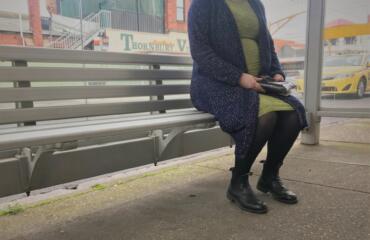Most of the conversations about the Voice to Parliament between Chelsea Daniel, studying in Melbourne, and her family in Western Australia, have been seeking the truth.
“Actually, no. That was fake. That was proven to be incorrect,” the 21-year-old recalled to The Citizen about one conversation the Yes-vote-leaning student had with her grandparents.
Daniel said her relatives usually “vote progressively”, but when it came to the referendum, “the only access they’ve had to information is misinformation.”
As the October 14 referendum date approaches, some young adults, many about to vote for the first time, have found themselves caught in a tug-of-war between the Yes and No campaigns.

“There’s a lot of misinformation and a lot of fear going around,” said Keshi Moore, an Indigenous student representative at the Melbourne Law School.

Keshi Moore, an Indigenous student representative at the Melbourne Law School, noticed fear and misinformation in the Voice debate. Photo: Keshi Moore
Moore told The Citizen that she was not able to disclose which way she intends to vote in the referendum as she was involved in an education program called Naarm Law student on Voice.
“The aim of these sessions [is] to promote education around the referendum, from a perspective of being neutral and, importantly, also Indigenous-led.”
Moore said that a campaign program maintaining neutrality had a “real market” given the blizzard of facts and misinformation targeting undecided voters.
In September, The Citizen spoke to a number of Australian students in Melbourne about the Voice and found a mix of support, opposition and hesitancy.
After growing up in Western Australia, Chelsea Daniel said that she wanted to make sure her Indigenous friends “have the voice that they want”.
Ladan Jhatane, a 19-year-old domestic student, is also a Yes supporter. “I think it’s something that is very necessary in Australia,” she said. “Especially considering our history and the fact that, for a long time, Aboriginal groups have been silenced.”
“We definitely should all vote yes to the Voice,” said George Piakis, a 22-year-old philosophy and politics student. “I think that it’s not nearly enough, but it is a really good step in the right direction.”
Wil Simmonds is undecided. “I’ve … seen lots of perspectives that disagree with the Voice and think that it furthers the separation between Aboriginal communities and other groups of people,” said the 18-year-old student, who is considering the arguments of the so-called “progressive no” and “conservative no” camps (which respectively oppose the Voice as too weak or too risky).
“The reasons I know some Aboriginal people are voting no are definitely more valid than just racist.”
Simmonds told The Citizen that he would research “factual” rather than “opinionated” sources before making the final decision.
“I was a 100% Yes voter,” said Luaren, who requested her last name not be disclosed due to the sensitivity of the debate. “[But] I’m … worried that it’s going to be a blanket excuse not to solve all of the issues that we have in the community.”
The 21-year-old Arts student told The Citizen that she wanted to be informed and hear as many Indigenous voices in the community as possible.
“There is a lot of information going around on … social media like Tik Tok … that I was influenced by,” she said.
Kirriley Bonett, a 23-year-old masters student, told The Citizen that she was fed videos on Tik Tok that stated Indigenous people wanting people to vote No.
“I am confused because my understanding of this was we should be voting Yes.”
A recent analysis by Guardian Australia of the top 10 Tik Tok videos with #voicetoparliament hashtag revealed that eight were from the No campaign. None of them are from the Yes campaign.
“Personally, I agree with the progressive No that the Voice is not enough,” said Kay Rae, a non-Indigenous RMIT student handing out the Yes campaign flyers in front of State Library Victoria.
Rae said she was concerned what voting No would mean for other objectives contained in the 2017 Uluru Statement from the Heart.

RMIT student Kay Rae campaigning for Yes votes at State Library Victoria. Photo: Gwen Liu
“[A] strategic Yes is important because, by not voting Yes, you’re putting back the Treaty, you’re putting back the Voice, you’re putting back the Truth-telling.”
“The majority of Aboriginal people want the Voice,” said Jill Gallagher, the chief executive officer of the Victorian Aboriginal Community Controlled Health Organisation. “Australians need to hear the 80 per cent not the … small amount of voices that say No.”
“My heart breaks that they have to ask so generously for the Voice,” said RMIT student Rae.
The latest data by Essential Poll revealed that the majority of the Voice supporters are in the age group of 18 to 34.
Rae pointed to the important role young cohorts played in the outcome of the last federal election, and said students may be decisive in whether Yes or No wins on October 14.
“If Yes is to get up, we really need young adults … speaking to their parents and their friends, and volunteering if they’ve got time.”



